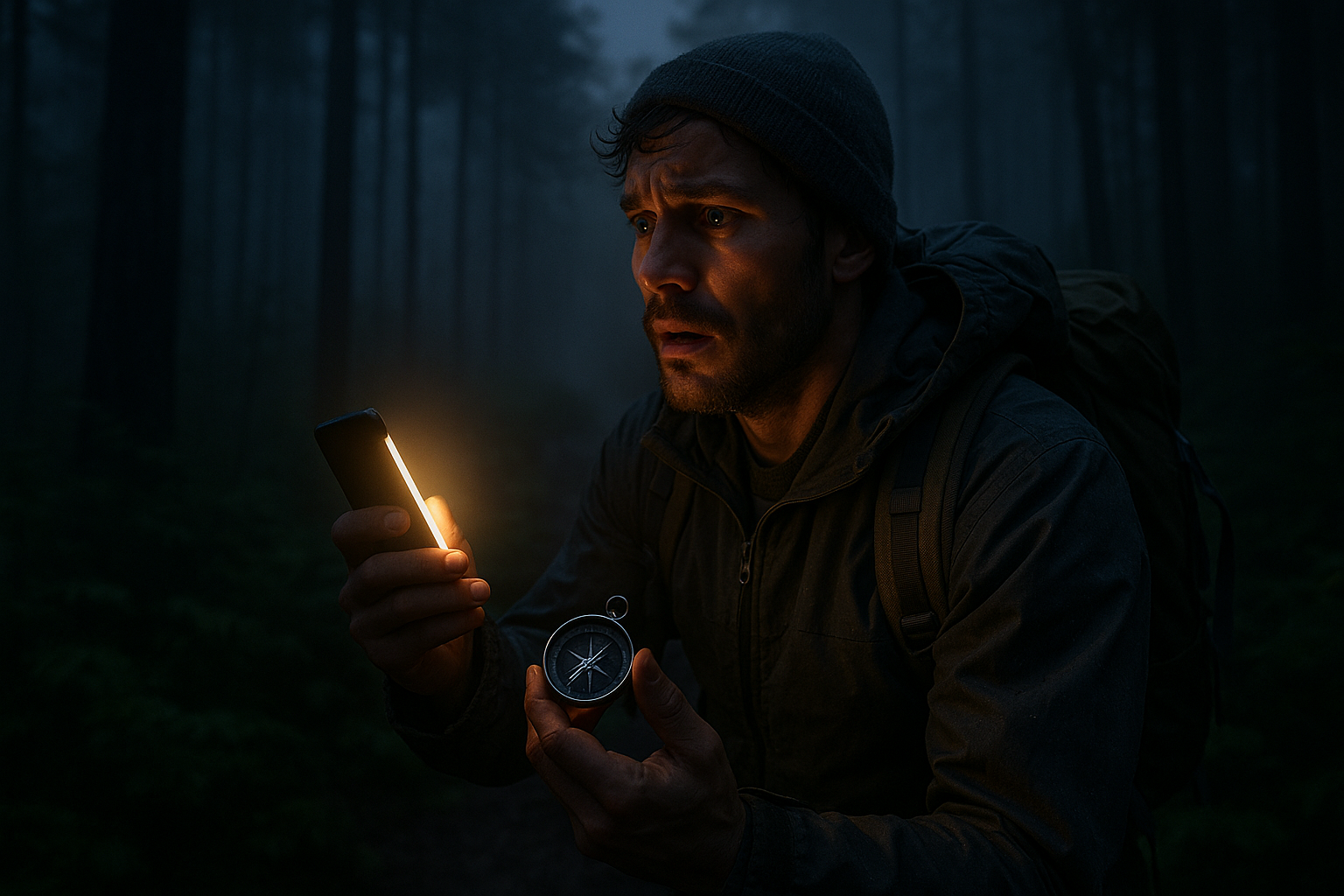It’s the kind of terror you don’t forget:
You set out for a casual day-trek, confident you’ll be back by sunset. But now the sun’s dropping, and you’re standing in a silent wilderness, with no idea where the trail went. Your heart races. Your phone’s dead. Panic claws at your gut.
If you’ve ever felt the raw dread of being lost in the wild as night closes in, this isn’t the time for clichés. Forget basic tips like “follow the sun” or “listen for a stream.” What you need are real, actionable tools you can deploy right now to stack the odds in your favor.
1️⃣ Field-Proven Signal Markers (Not Just Bright Clothing)
Forget hoping a search party will spot you waving a jacket. The real pros use compact, high-visibility signal tools like reflective trail markers or mini-flash signal mirrors. Keep one clipped inside your pack:
- 3M Reflective Trail Tape: Tie strips every few meters on trees as you backtrack; at dusk, even a faint headlamp reflection makes them pop.
- Mini Signal Mirror (with sighting hole): Reflect the last rays of sunlight toward high ground or passing aircraft. A focused flash can travel miles.
These tools create an active breadcrumb trail and increase your visibility long before anyone starts searching.
2️⃣ Ultralight Magnetic Compass with Glow Markings
When GPS dies or reception drops, an ultralight magnetic compass with glow-in-the-dark indicators can be your savior. It doesn’t rely on batteries and works through tree cover. Pack a model with:
- High-contrast dial for low-light conditions.
- Luminous pointer to keep bearings clear at dusk.
A compact version (like the Suunto Clipper or Silva’s micro-compass) clips to your jacket or pack strap.
3️⃣ Improvised Shadow Stick Sun Tracker
Caught without a compass? As the sun dips low, use a shadow stick:
- Find a straight stick and push it into the ground.
- Mark the tip of its shadow.
- Wait 15 minutes; mark the new tip.
- Draw a line between the two marks—this line runs roughly west to east.
Now orient yourself with natural features and begin a careful backtrack along terrain you recognize.
4️⃣ Miniature Survival Whistle with Pealess Design
Sound travels farther than you think—especially in quiet wilderness. A pealess survival whistle (like the Fox 40 Micro) is small but mighty:
- Three short blasts are the international distress signal.
- Pealess designs won’t clog or freeze in cold conditions.
Blow intermittently as you move to increase chances of being heard, especially near natural sound corridors like ridgelines or open valleys.
5️⃣ Ultralight Emergency Strobe with Red Mode
When night starts creeping in, visibility drops. An ultralight emergency strobe with a red-light mode can:
- Preserve your night vision.
- Avoid blinding yourself in darkness.
- Act as a beacon for rescue teams.
Models like the Black Diamond Spot R or Nitecore NU25 UL clip to hats or packs, flash in SOS patterns, and weigh practically nothing.
6️⃣ Compact, Pre-Marked Map in Waterproof Sleeve
Phones die. Apps crash. Always pack a pre-marked paper map, even a small printed section of your route:
- Highlight key landmarks (ridges, streams, unique tree formations).
- Mark a bearing from your start point.
- Store in a ziplock or waterproof sleeve for weather resistance.
Even in low visibility, landmarks combined with a compass or shadow stick can guide you home.
7️⃣ Lightweight Reflective Cord for Quick Perimeter Safety
In unfamiliar terrain, especially as darkness falls, you risk circling back into danger or losing your bearings. Reflective cord (like Night Ize reflective utility cord) can be:
- Strung between trees as a guide perimeter around a temporary shelter.
- Marked with trail tape or glow sticks to make re-entry points visible.
This creates a safe zone you can orient back to if disoriented.
Real Talk: Field-Tested Is Field-Survivable
When you’re lost on a day-trek and the light is fading, every second counts. Forget the stuff that sounds smart but fails in practice. Instead:
✅ Reflective markers create a visual path home.
✅ Compact compass or shadow stick restores direction.
✅ Signal tools (whistle, mirror, strobe) get you seen and heard.
✅ Map and reflective cord keep you safe and oriented.
None of this gear is bulky. Most fit in a pocket, weigh less than a candy bar, and cost under $20 on Amazon.
Before you even step on the trail, pack these tools and practice using them. Because when it’s you against the night, you’ll want the advantage that gets you back alive.
Optional Amazon Gear List
- 3M Reflective Trail Tape (Amazon)
- Suunto Clipper Micro Compass (Amazon)
- Fox 40 Micro Pealess Whistle (Amazon)
- Nitecore NU25 UL Strobe Headlamp (Amazon)
- Night Ize Reflective Cord (Amazon)
Conclusion: Darkness Doesn’t Have to Win
Being lost isn’t just disorienting—it’s dangerous. But with a handful of field-tested, pocket-sized tools, you can shift from helpless to prepared. Whether it’s a compass, reflective tape, or a whistle, these aren’t just nice-to-haves—they’re what stand between you and a sleepless, shivering night lost in the wild.
Next time you set out, don’t just pack gear—pack your survival advantage.

